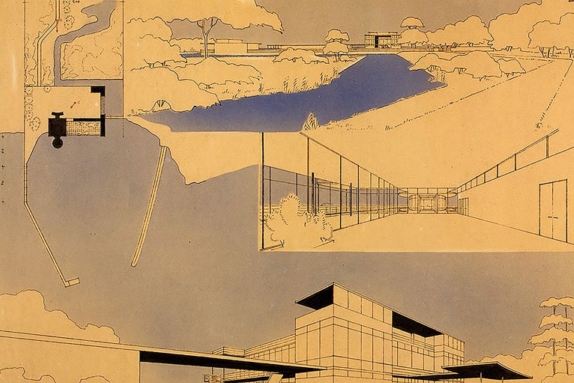
Hanns Dustmann, Walter Gropius, and Franz Möller, Club House,
Argentina, 1931– 1932: Site plan and perspectives, 1931–32.
Photomechanical print with ink and blue wash on paper. Harvard Art
Museums/Busch-Reisinger Museum, Gift of Walter Gropius, BRGA.60.6.
Walter Gropius and Francis Möller opened a joint architecture firm in
the city in 1931. Their plans for a seaside resort are shown alongside
the designs of Argentine architects Jorge Ferrari Hardoy and Juan
Kurchan for residential developments.
“Displaying Latin America,” on view at the Harvard Art Museums through May 12, explores the architectural developments of Buenos Aires in the interwar period. Walter G ropius and Francis Möller opened a joint architecture firm in the city in 1931.
Their plans for a seaside resort are shown alongside the designs of Argentine architects Jorge Ferrari Hardoy and Juan Kurchan for residential developments.
The exhibition is displayed to supplement an ongoing course at the university under the same name, but it provides the public with interesting insight into the design process and the differences between Argentine and international architects’ approaches. Gropius and Möller were commissioned to design Ciudad Balnearia de Chapadmalal, a large-scale seaside resort.
This required a departure from the prefabricated one-floor homes that Gropius is known for. The designs allow visitors to see how his Bauhaus theories translated to this different culture and environment.
Visitors can see the breadth of the design process, from base floor plans to photographs of the finished buildings. Drawings by Ferrari Hardoy and Kurchan of the residential building Los Eucaliptos in Virrey del Pino illustrate a desire to merge the Argentine landscape with the modernist building. Eucalyptus trees are woven into the structure of the building and the surrounding compound features a lush, extensive garden separating the building from the road. Whereas the seashore appears to be merely the location of the Gropius compound, the setting for Los Eucaliptos is an essential piece of the building itself.
Ferrari Hardoy and Kurchan’s plans are often painterly, sketched with graphite and mixed media on tracing paper and including colored windows and miniature people engaging with the building. This organic style contrasts with the more geometric plans of Gropius and Möller, whose designs are illustrated through photomechanical prints with light color washes on off-white paper.
The two Argentine architects also worked on larger urban planning projects of Buenos Aires with Le Corbusier, and designs for their vision of the city are included. These provide an interesting context to Los Eucaliptos, showing the broader city that Ferrari Hardoy and Kurchan hoped to populate with similar residences.
Compared with the other exhibitions on display that delve into Gropius’s Bauhaus legacy, “Displaying Latin America” illustrates the Bauhaus style in other cultural contexts while also highlighting native architects. The show reveals the architectural nuts and bolts of the country often associated with images of the Madres de la Plaza Mayo searching for their disappeared loved ones or the fiery tango being performed at bustling milongas.
ON THE WEB
LEARN MORE AT: www.harvardartmuseums.org/visit/exhibitions/5830/displaying-latin-america
IF YOU GO
WHERE: The Harvard Art Museums
WHEN: Through May 12, 2019